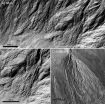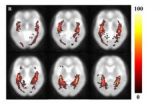(Press-News.org) A research team lead by Academy Professor Kari Rissanen at the University of Jyväskylä has discovered a new water-soluble fluorescent detection system that is extremely sensitive to pyrophosphate (PPi).
Pyrophosphate has a key role in energy transduction, DNA replication and other metabolic processes that are dysregulated in cancer cells.
The discovery might lead to the development of a method for early detection of cancer cells.
The team developed a simple metal complex which shows an intense orange fluorescent color in the presence of very low concentration of pyrophosphate (PPi) in water. The complex, also called a probe, had almost 1000 times higher level of response than earlier methods and an unprecedented sensitivity to detect PPi at a sub-nanomolar level (LOD ~0.8 nM). The discovery represents the first water-soluble fluorescent sensor that is capable of detecting pyrophosphate at this sensitivity level under physiological conditions.
The highly sensitive probes or sensors that are able to report the PPi level could lead to improved cancer diagnostics, since PPi plays a key role in energy transduction, DNA replication and other metabolic processes that are seriously misbehaving in cancer cells. All earlier PPi-selective sensor molecules or complexes have suffered from poor water solubility and low sensitivity in water. They can reach only micromolar levels and, thus, researchers have had to rely on protein-based probes that have their own limitations.
The researchers were able to show that the probe can image the pyrophosphate in the nuclei of living (HeLa) cells, making it an excellent probe for live cell pyrophosphahe imaging (Figure 1). The HeLa cells, originally from Henrietta Lack's cervix carcinoma, are the most long-lived human cancer cell line and are often used as a cancer cell model. In addition to their applicability in water, they can easily be formulated into a hydrogel and coated onto paper strips for low-cost pyrophosphate detection.
INFORMATION:
S. Bhowmik, B. N. Ghosh, V. Marjomäki and K. Rissanen, Nanomolar Pyrophosphate Detection in Water and in a Self-Assembled Hydrogel of a Simple Terpyridine-Zn2+ Complex, J. Am. Chem. Soc. 136 (2014), 5543–5546.
The work is also highlighted in the cover of the issue: http://pubs.acs.org/action/showLargeCover?jcode=jacsat&vol=136&issue=15
and also in the selected spotlights in the same issue
http://pubs.acs.org/doi/full/10.1021/ja5035039
More information:
Academy Professor Kari Rissanen
+358 50 5623721
kari.t.rissanen@jyu.fi
Docent Varpu Marjomäki
+358 40 5634422
varpu.s.marjomaki@jyu.fi
New sensor molecules have potential for early cancer detection
2014-04-25
ELSE PRESS RELEASES FROM THIS DATE:
Researchers at LSTM part of the international team to sequence the tsetse genome
2014-04-25
Researchers from LSTM are among those who have sequenced the genome of a species of tsetse fly (Glossina morsitans). The outcomes of this research will be invaluable to understanding more about the tsetse and other insect vector biology, knowledge which can be applied to improving the current vector control methods and may lead to more effective and affordable control strategies.
A paper summarising some of the findings will be published in the journal Science today, with more specific and in depth analyses of various aspects of tsetse biology being published as a collection ...
Know your enemy
2014-04-25
Researchers at Aarhus University, Denmark, have drawn up the most detailed 'image of the enemy' to date of one of the body's most important players in the development of Parkinson's disease. This provides much greater understanding of the battle taking place when the disease occurs – knowledge that is necessary if we are to understand and treat Parkinsonism. However, it also raises an existential question because part of the conclusion is that we do not live forever!
Parkinson's disease is one of the most common neurological disorders, with about 7000 people suffering ...
3D printing cancer tumors
2014-04-25
Drexel's Wei Sun, PhD, Albert Soffa chair professor in the College of Engineering, has devised a method for 3D printing tumors that could soon be taking cancer research out of the petri dish.
Using a mixture of cervical cancer cells and a hydrogel substance that resembles an ointment balm, Sun can print out a tumor model that can be used for studying their growth and response to treatment. This living model will give cancer researchers a better look at how tumors behave and a more accurate measure of how they respond to treatment.
"This is the first time to report ...
Study reaffirms soy-dairy protein blend increases muscle mass
2014-04-25
A new study published online in the Journal of Applied Physiology shows additional benefits of consuming a blend of soy and dairy proteins after resistance exercise for building muscle mass. Researchers from the University of Texas Medical Branch found that using a protein blend of soy, casein and whey post-workout prolongs the delivery of select amino acids to the muscle for an hour longer than using whey alone. It also shows a prolonged increase in amino acid net balance across the leg muscle during early post-exercise recovery, suggesting prolonged muscle building. ...
Nitrogen pollution, climate and land use: Why what we eat matters
2014-04-25
A new report quantifies for the first time how much our food choices affect pollutant nitrogen emissions, climate change and land-use across Europe.
The executive summary of the European Nitrogen Assessment Special Report on Nitrogen and Food, 'Nitrogen on the Table', was released today (Friday 25 April 2014). The Special report provides an assessment of what would happen if Europe were to decrease its consumption of meat and dairy products. It shows how much cutting down on meat and dairy in our diets would reduce nitrogen air and water pollution, and greenhouse gas ...
A civil war inside our cells: Scientists show how our bodies fight off 'jumping genes'
2014-04-25
ANN ARBOR, Mich. — There's a civil war going on inside every one of the 37 trillion cells in your body. Now, University of Michigan scientists have uncovered how your cells keep this war from causing too much collateral damage.
On one side of the battle: your "regular" DNA, which provides the day-to-day instructions for life. On the other side: tiny bits of rogue DNA that hide like spies between genes in your own DNA. From time to time, these rogue bits of DNA spin off a copy of themselves and "jump" to another DNA location – often causing harmful mutations when they ...
Traces of recent water on Mars
2014-04-25
The southern hemisphere of Mars is home to a crater that contains very well-preserved gullies and debris flow deposits. The geomorphological attributes of these landforms provide evidence that they were formed by the action of liquid water in geologically recent time.
Evidence of liquid water
When sediment on a slope becomes saturated with water, the mixture may become too heavy to remain in place, leading to a flow of debris and water as a single-phase unit. This is called a debris flow. Debris flows on Earth often cause significant material destruction and even human ...
Tsetse fly genetic code sequenced
2014-04-25
Scientists at the University of Liverpool have been part of a ten-year project which has successfully sequenced the genetic code of the tsetse fly – making major advances in disease control possible.
Tsetse flies are unique to Africa and can infect people bitten by them with sleeping sickness, a disease which damages the nervous system and is fatal if untreated. This kills over 250,000 people each year.
Traditional methods of control such as releasing sterile males, trapping and pesticide spraying are expensive and difficult to implement. Sleeping sickness can also ...
Quantitative volumetric analysis of the optic radiation in the normal human brain
2014-04-25
The optic radiation is a dense fiber tract that emerges from the lateral geniculate nucleus and continues to the occipital visual cortex. Especially, the optic radiation is an important fiber structure that conveys visual information from the lateral geniculate nucleus to the primary visual cortex in the occipital lobe. Current studies have focused on the anatomical characteristics of optic radiation fiber tracts in individual brains and on comparisons of the anatomical characteristics of the optic radiation fiber tracts between patient and control groups. Therefore, no ...
Climate change: Don't wait until you can feel it
2014-04-25
Washington, D.C.— Despite overwhelming scientific evidence for the impending dangers of human-made climate change, policy decisions leading to substantial emissions reduction have been slow. New work from Carnegie's Katharine Ricke and Ken Caldeira focuses on the intersection between personal and global impacts. They find that even as extreme weather events influence those who experience them to support policy to address climate change, waiting for the majority of people to live through such conditions firsthand could delay meaningful action by decades. Their findings ...


